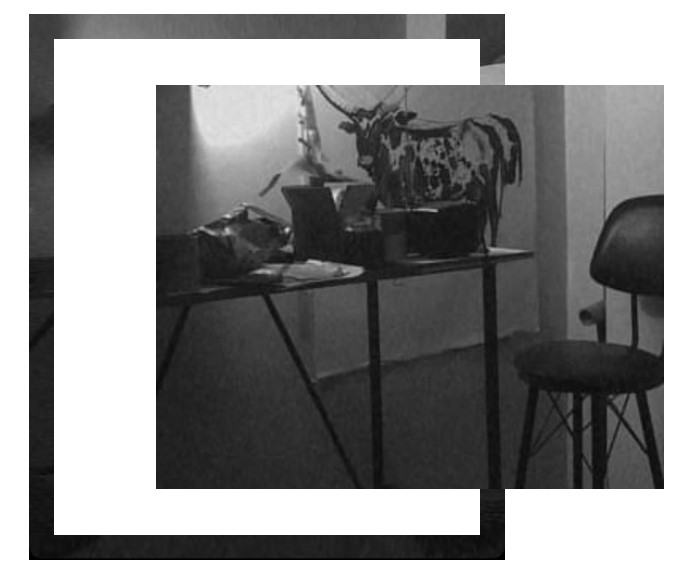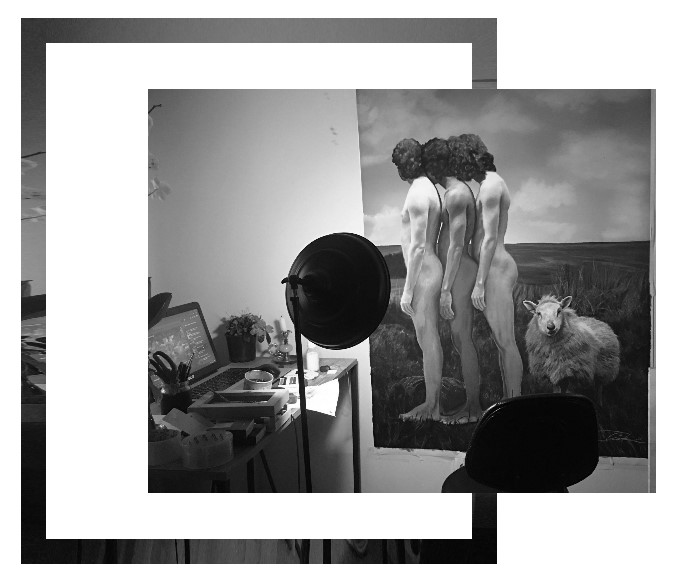The artist started his view of art by facing the mirror and continued by examining the conversations and thoughts of the individual in his inner world. His works shed light on Freud’s reflection problem, which is the basis of the philosophy of reflection. The logical structure of the relationship between thinking and being replaces the logical structure of the mirror-reflected, with the answer to the question “How does the individual relate to himself in his own world”. Through figurativism and surrealism, he encourages the viewer to feel empathetic yet restless, rather than feeling that the painting is just an imitation of reality.
By contributing to the meaning of existence, the most basic emphases of a subconscious mind are examined. The individual’s getting rid of his essence and confronting the illusory reality is handled with his anxieties in art, and with the dark effect of coal, it directs the viewer to an unconventional point of view.


The Unconscious Between Darkness and Light
The image, which is deeply followed in the field of art, is actually a phenomenon that people use unconsciously in their vital activities. When the image is considered as an imitation or analogy, it is seen that the main thing is its reflection. Reflection separates the subject from the object world and gives him freedom as a “thinking being”. In order to be a thinking being, the basic thing that separates you from others, your self, must come into play. The “I” as the subject will have to think about the “I” as the object.
A self should detach internal and external stimuli from art and synthesize it in its own world, and add information worth interpretation to itself. If detection is clear, interpretation will be easy. The ego’s capacity to perceive internal and external stimuli is limited. Therefore, some warnings cannot be detected, some are perceived but ignored, some are perceived and interpreted. From this point of view, we can divide perception into two as conscious and unconscious. Most of the detection process is done unconsciously. For example, two people perceive most of what is happening and spoken in their relationship, but does not record all of it in their mind.
If these two people talk about their relationship, it is seen that they do not remember some events at all, if they are mentioned, they remember some, and some of them both remember very well but differently. If these two people were to tell someone else about their relationship, they would talk about each other and their relationship about something else. Apart from all these conversations, people also have thoughts that they think within themselves but do not tell anyone. If one of these people has a dream about the other and a psychoanalytic evaluation is made of this, thoughts about his friend that he is not conscious of may arise. One gets closer to his own unconscious.
Unconscious psychic processes are not symbolized by words, they are of a pre-word nature. Therefore, the unconscious cannot be reached. As soon as the unconscious symbolizes, the self is activated.
This is one of the main reasons for using the unconscious in works. While painting the unconscious of different individuals, the combination with their own unconscious in the individuals who actually see and perceive it provides some confrontation. In this confrontation Unconscious desires, impulses and memories are not subject to the rule of opposition. That is, the opposing elements can be side by side, intertwined, as in dreams. For example, in pictures, a woman may have a beard, a continuation of a male body may be a female limb, multiple legs may appear from one leg, or a human face may have more than two eyes. The merging of more than one body, which is deformed in the works, sometimes stays in the void, and sometimes gets stuck in a space. In fact, in this process, the unconscious mental processes arise because they do not know time and space. They do not need cause-effect relationships. Why do bodies lie in bed? , Why does he look dead?, Why is he pictured in the desert? As such, a connection cannot be searched, a relationship cannot be established. They are weak in relation to reality. External reality has been replaced by psychic reality. This is how we can explain the bodies swimming in the sea, getting lost in the straw, flying in the clouds, meeting the plants.
The unconscious whole and part relationship does not recognize reality. A part can represent the whole. Only the same body can move through the composition with full repetition, or parts can easily change places. The landscape in the selected memory can continue, repeat, or be reflected more than once. It can create a pattern or transition to another utopia without disturbing the reflection.
Here, a generalization that distorts the classifications of reality comes into play. This process is also characteristic of primary process thinking. Primary process thinking is under the control of the pleasure principle. There is only one reason why I incorporate the pleasure principle into my art; It is the pleasure or discomfort of the audience in the process of perception and confrontation. Again, your unconscious will decide this satisfaction or dissatisfaction. How is my self reflected here in the pictures you look at? There may be situations where you will be asked the question over and over again. Thoughts, feelings and memories that carry the traces of your unconscious will find a place in your dreams, in which you linger for two seconds during the day. It’s not just limited to dreams, we can magnify this reflection process from your dreams to your fantasies. Daydreams are associated with important fantasies, fantasy remnants, and memory patterns. They may come to your mind when you are free, before you go to sleep, or during daydreaming. Likewise, dreams are items from the unconscious. Traces of your unconscious can be reached by speaking freely about both the dream content and the dream content. So even if you can’t find a reflection of yourself in any way, I can reach your unconscious after seeing the pictures and starting to perceive. Now, while my images are filtering into your unconscious, they can come to life in a dream beyond your control, come to life in the third dimension.
The subject of the unconscious is an open subject that every surrealism artist deals with and is fed by Freud. The fact that the fixed style used in the paintings made by being influenced by the theories of Freud, the founder of psychoanalysis, about the layers of the mind, is actually hypnosis, eliminating the perception problem. The aim is to reach you by shortening the focusing process, regardless of the technique. In some works, a single exploded color is used to make a perception game. Purpose of this; The principle of “look at me”, “see me” is applied to the audience by establishing a back-to-front relationship. Even if the viewer could not find himself in the painting, attention was drawn.
And now an Esra Turk has entered your subconscious.